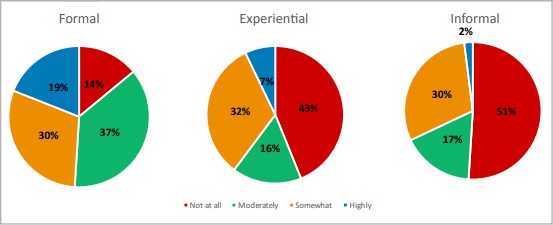Measuring the ROI of Informal Learning
Shauna Carson
Return on investment - it's what it always comes down to in business. Whether it's the purchase of a new building or a course registration fee, the question asked is "What are we getting out of it?"
Formal learning in the workplace has always had testing, performance assessment, certification and other means of determining how many people took and successfully completed a given program. There has always been some way of measuring formal learning results and quantifying the return on investment on that learning. But what's the ROI on informal learning? How do you measure something that occurs naturally, without assessments, and produces no records?
In this article, I'll discuss what informal learning is, talk about the benefits of informal learning in the workplace and describe how to measure the ROI of informal learning.
What is Informal Learning?
The vast majority of the learning delivered within organizations is through formal classrooms and e-learning courses, which only accounts for about 10% of the learning that occurs. - Brandon Hall Group, 2015
Informal learning is the learning that takes place anytime, anywhere through observation of, and interactions with, other people.
Let's look at learning from a recreational perspective; golf for example. When a person first starts to learn the game, he or she takes some lessons (or they should) and practices what they have learned at the driving range. That's the formal learning part.
Then, the beginner goes out with friends, starts playing and plays poorly. But, they also watch their more experienced friends play and learn what does and doesn't work. They ask questions and get tips on stance, swing, equipment, rules of the game and mental attitude (or how not to let golf make you mental). They receive guidance on the course itself, how to play certain shots and what to avoid. The beginner golfer also learns from their mistakes, their bad shots and their good ones. They decide when and where to play, who they will play with and how many holes they'll play.
Over a couple of seasons, all of this accumulated knowledge is filtered - the useful is kept and applied and the useless is discarded. And, although there are no formal lessons, coaching or classrooms, the beginning golfer's game improves.
The learner has learned through observation, interaction and self-discovery, and they will continue to learn that way for as long as they continue to play.
How is Informal Learning Different from Social Learning?
I asked this question as I started researching this article.
Marcia Connor defines social learning as "participating with others to make sense of new ideas". Informal learning is where "the learner sets the goals and objectives" (Cofer, 2000). So, what separates the two? Well, it turns out that they are two different aspects of learning as illustrated by this diagram.

Source: Integrating Formal, Informal and Social Learning
Informal learning can be social, but doesn't have to be and social learning can be informal or formal, depending on what needs to be learned. It sounds like the free schools of the late '60s!
Now, you're probably thinking, "Hold the flower power and turn down the Hendrix! Where's the ROI?" Well, that discussion begins with the benefits of informal learning.
How Does the Workplace Benefit from Informal Learning?
In any discussion on benefits of workplace learning, there are two questions:
- How does the organization benefit?
- Who benefits the most from the learning?
Benefits for the organization
Companies, associations and businesses can benefit from promoting and fostering informal learning because it:
- Costs less than formal learning - The "learning content" comes from the expertise of the workforce. There are no development or delivery costs as this knowledge is openly shared. By promoting open dialogue between employees, encouraging and recognizing voluntary mentorships and fostering a "community" environment at the workplace where knowledge is shared socially, the organization has a happier and better-informed workforce at little or no cost.
- Creates a variety of new learning resources - Learning developers spend countless hours creating documented knowledge for training purposes. This is called "explicit knowledge". But how does a newer employee learn things such as which clients are difficult to work with or how to restart that pump that "only old Joe knows how to get going"? This type of knowledge is difficult or impossible to document and needs to be transferred through personal interaction and experience. This is called "tacit knowledge". Explicit and tacit knowledge are both useful and necessary in the workplace, but the value of tacit knowledge is often overlooked. Promoting informal learning within your organization is an excellent way of capturing and transferring tacit knowledge rather than watching it walk out the door when Joe retires.
- Provides a view of the other side of workplace learning - According to the 70-20-10 learning model, only 10% of the learning we do happens formally, 20% happens socially and 70% of our learning is informal. Capturing what was learned and how it was learned offers an amazing opportunity to understand and promote informal learning. Letting employees set up online discussion groups, bulletin boards and devise other ways to record their learning experiences will add depth to your training programs and foster greater learner involvement in them.
Who benefits the most from informal learning?
While everyone in an organization benefits from informal learning in one way or another, some groups benefit more than others. These include:
- Older workers - According to an Australian Bureau of Statistics (ABS) study, older people are more inclined to engage in informal learning because they are often perceived as "having less capacity to learn". That same study showed that 74% of respondents aged 25 to 64 years old engaged in some type of informal learning in the 12 months prior to the study. In Skills Development for an Older Workforce (2008), Ferrier, Burke and Selby Smith comment that, for the most part, training for older workers tends to be "reactive" and more likely delivered in an informal manner.
- Small Businesses - According to Informal Learning at a Glance (National Centre for Vocational Education Research), more small business owners learn informally through discussions with peers and suppliers than in formal education programs. More often than not, small businesses do not have the budget for formal training and so owners, managers and staff rely on informal training as a way of learning their business.
The amount of training undertaken by small-to-medium businesses may be underestimated due to the informal nature of much learning in these enterprises. - Informal Learning at a Glance - National Centre for Vocational Education Research
- Disinterested learners - Those who have "dropped out" or have simply become disinterested in formal learning because of literacy or learning challenges benefit from informal learning because of the observation and participation it involves. This type of learner is more likely to become engaged when shown how to do something and then allowed to practice it on their own. The benefit here is that learners who would otherwise be limited to low skill level positions can advance themselves. They may be encouraged by what they accomplish and seek out more learning opportunities, increasing their skill level and value to the organization.
- New immigrants and refugees - English-as-a-second-language (ESL) learners have their own set of challenges in formal workplace learning. For those entering the workplace at no or low skill level jobs, the written and spoken English in classrooms or in eLearning is too complex. As well, these workers typically have little or no formal education in their own language. Those who are more skilled and know how to do their jobs may have problems advancing in the workplace because of low English literacy levels. For these learners, informal learning opens paths at work and allows them to integrate into their adopted culture.
Informal learning can provide new migrants and refugees with important foundation skills to integrate into their new communities, upon which further learning can be built. - Informal Learning at a Glance - National Centre for Vocational Education Research
Measuring the ROI of Informal Learning
It seems like measuring the ROI of informal learning is measuring the unmeasurable. How do you quantify a type of learning that has no tests, no formal schedule or attendance records and has no direct supervision? It seems impossible, yet it can be done.
Most organizations cannot or do not measure ROI on informal learning. The 2015 Brandon Hall Group Learning Strategies study examined how organizations measure learning. Only 2% of companies surveyed claimed that they were highly effective at measuring informal learning while 51% said they weren't at all effective.

In their research brief, Measuring the ROI of Informal Learning, the Brandon Hall Group Research Team describes how the ROI of informal learning can be measured. In short, it comes down to:
- Basic numbers - the number of participants, satisfaction with the learning (ease of comprehension, engagement level, relevance to work tasks, etc.) and performance after the learning (assessments, performance reviews, assignments, etc.).
- Performance measurement - performance improvement, increased efficiency, speed in achieving competencies, effect on business.
- Informal learning-specific measurements - who the participants are, who the employees that are the primary or most sought-out source of information are, the knowledge most shared, the tools used to accomplish the learning (video, mobile learning, social learning, web searches, etc.).
When all of this data is factored in, the calculation of ROI is the same as it is for formal learning. If an organization regularly calculates ROI it can use the same formula here. The Brandon Hall Group Research Team offers three ways to calculate ROI:
- ROI = (Benefits / Costs) X 100
- ROI = (Benefits - Costs) / Costs X 100
- ROI = (Benefits - Costs) / Costs X 100 X (%A) X (%P) - (a forecasted calculation where %A is the percentage of learners expected to participate and %P is the percentage of learners who do participate)
Conclusion
Informal learning is the learning that happens outside of classrooms, seminars, eLearning programs, textbooks and manuals. Simply put, informal learning is the way we learn most of what we know. This article has discussed the importance of informal learning, as well as the benefits (both to the organization and the learner) of promoting informal learning in the workplace.
Finally, we looked at the return on investment on informal learning, and how it can be measured. I strongly recommend reading the Brandon Hall Group brief Measuring the ROI of Informal Learning if you want more in-depth information on this topic.
Free eBook
Measuring Training Effectiveness
Learn how to properly measure and optimize the ROI and overall effectiveness of your training program!
📘 Ready to Elevate Your Learning Strategy?
Explore our comprehensive library of eBooks and tools on learning resource development, competency-based learning, and LMS implementation. Transform your training programs with insights from industry experts and practical templates.
Shauna Carson
Shauna graduated from the University of Toronto in 2002 with a Master of Arts in English before moving home to Calgary to work in the fast-paced, detail-oriented oil and gas industry. Now certified as a technical writer, Shauna is comfortable writing in a variety of styles, and for a variety of audiences.

